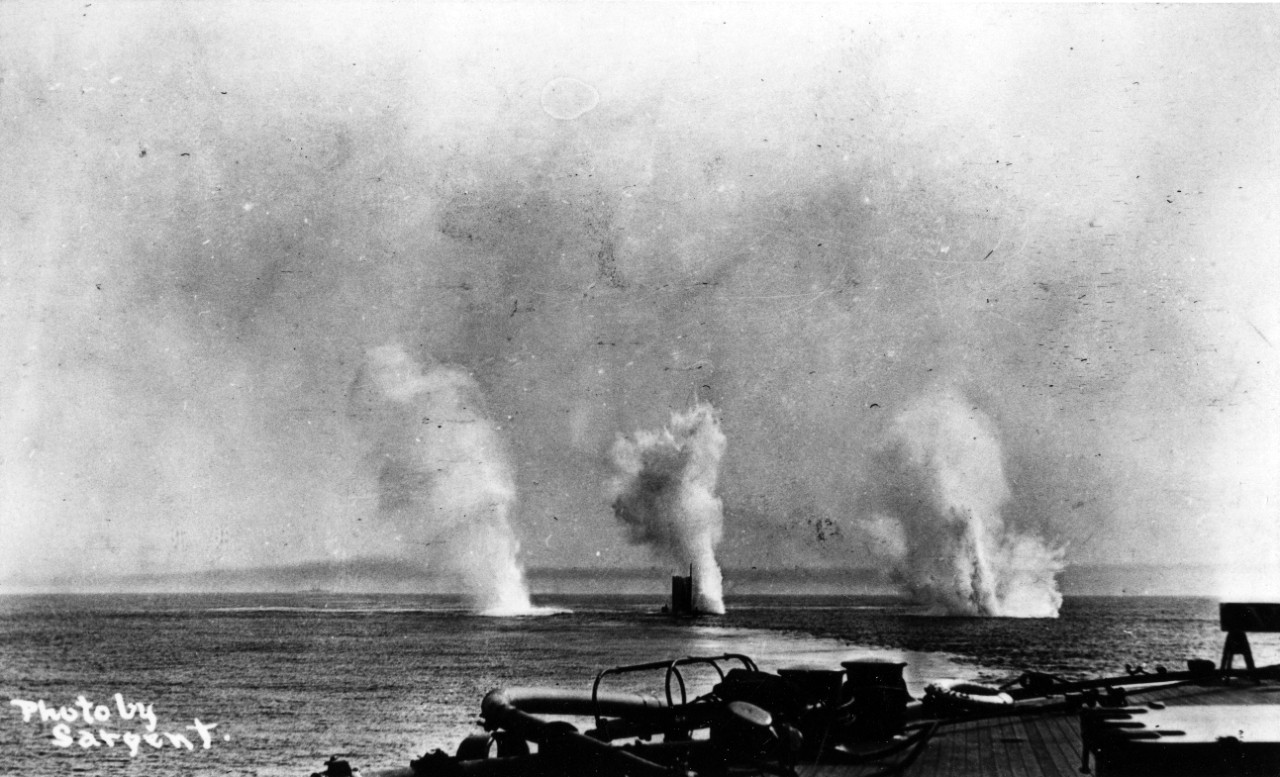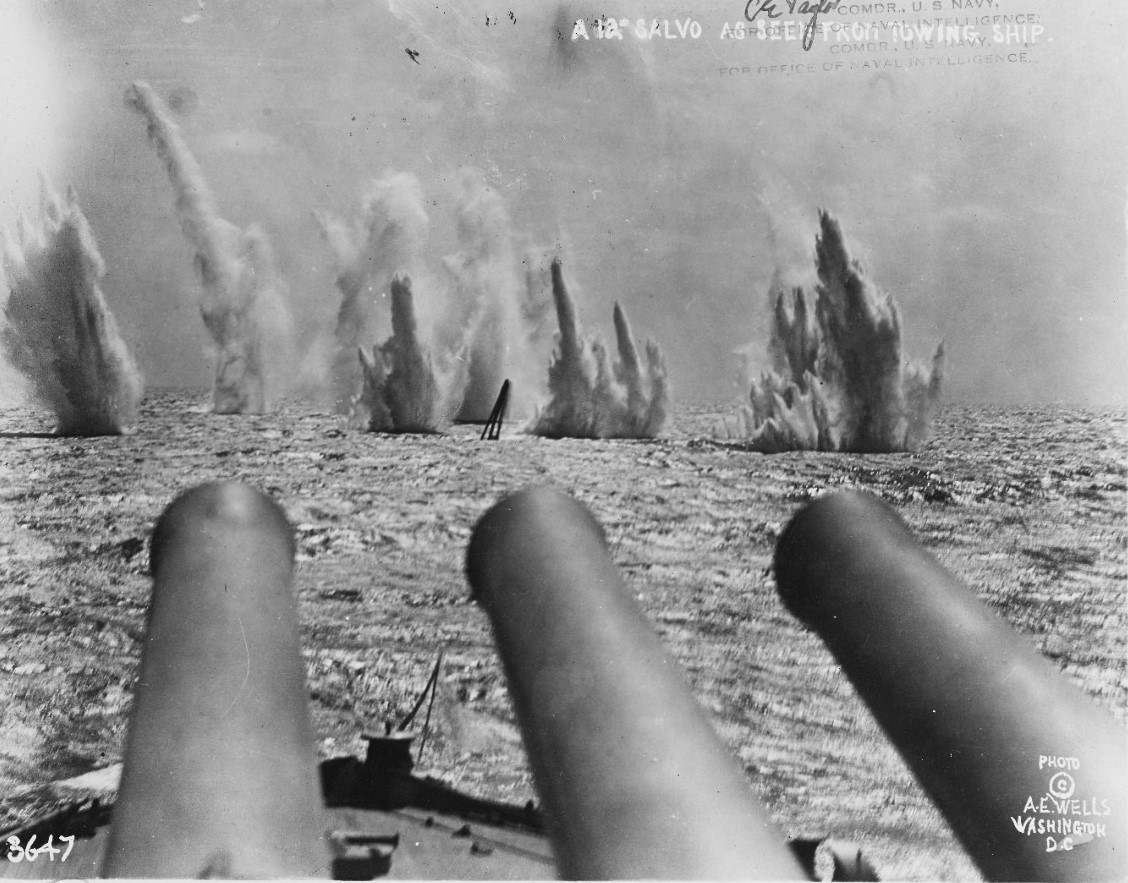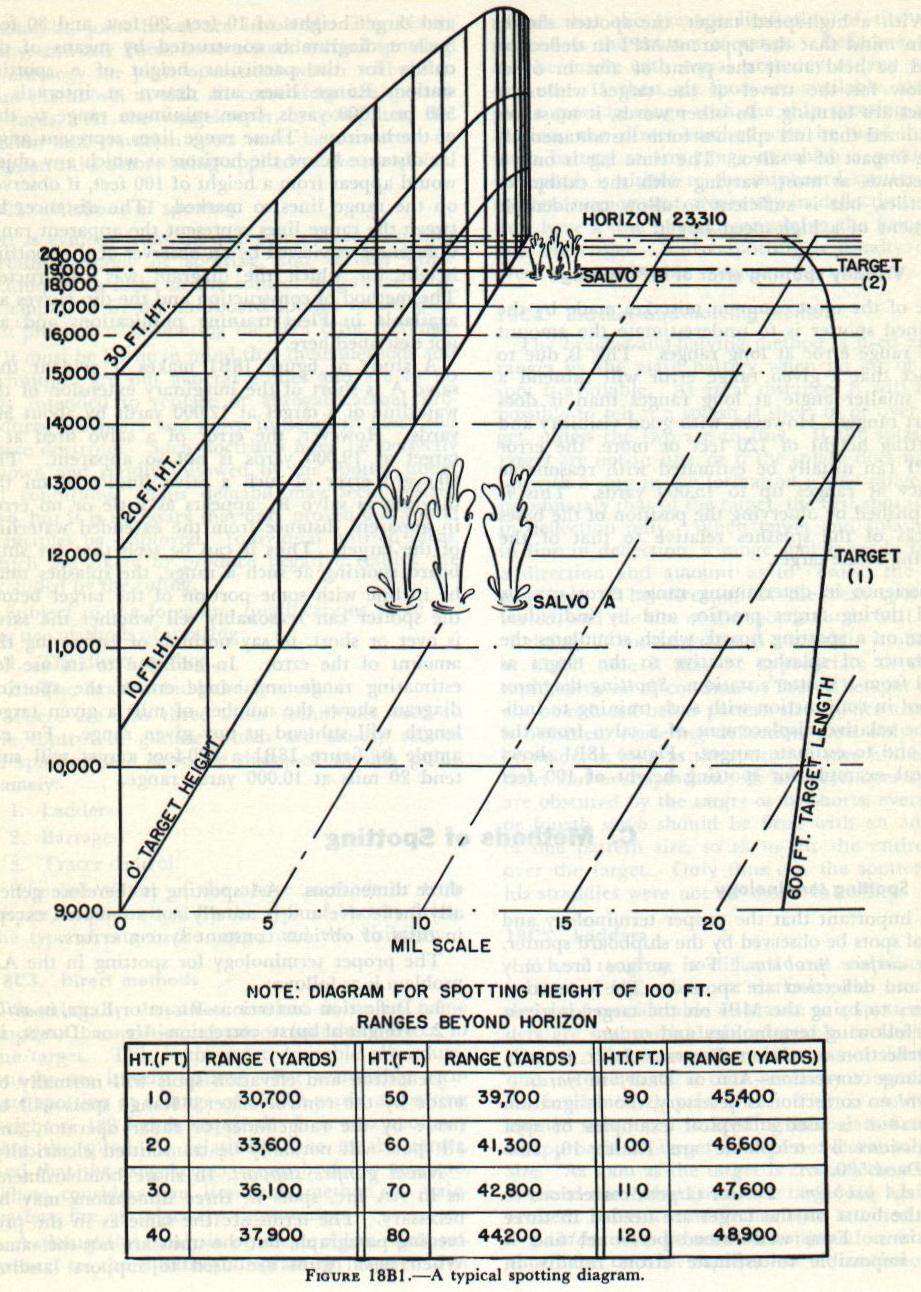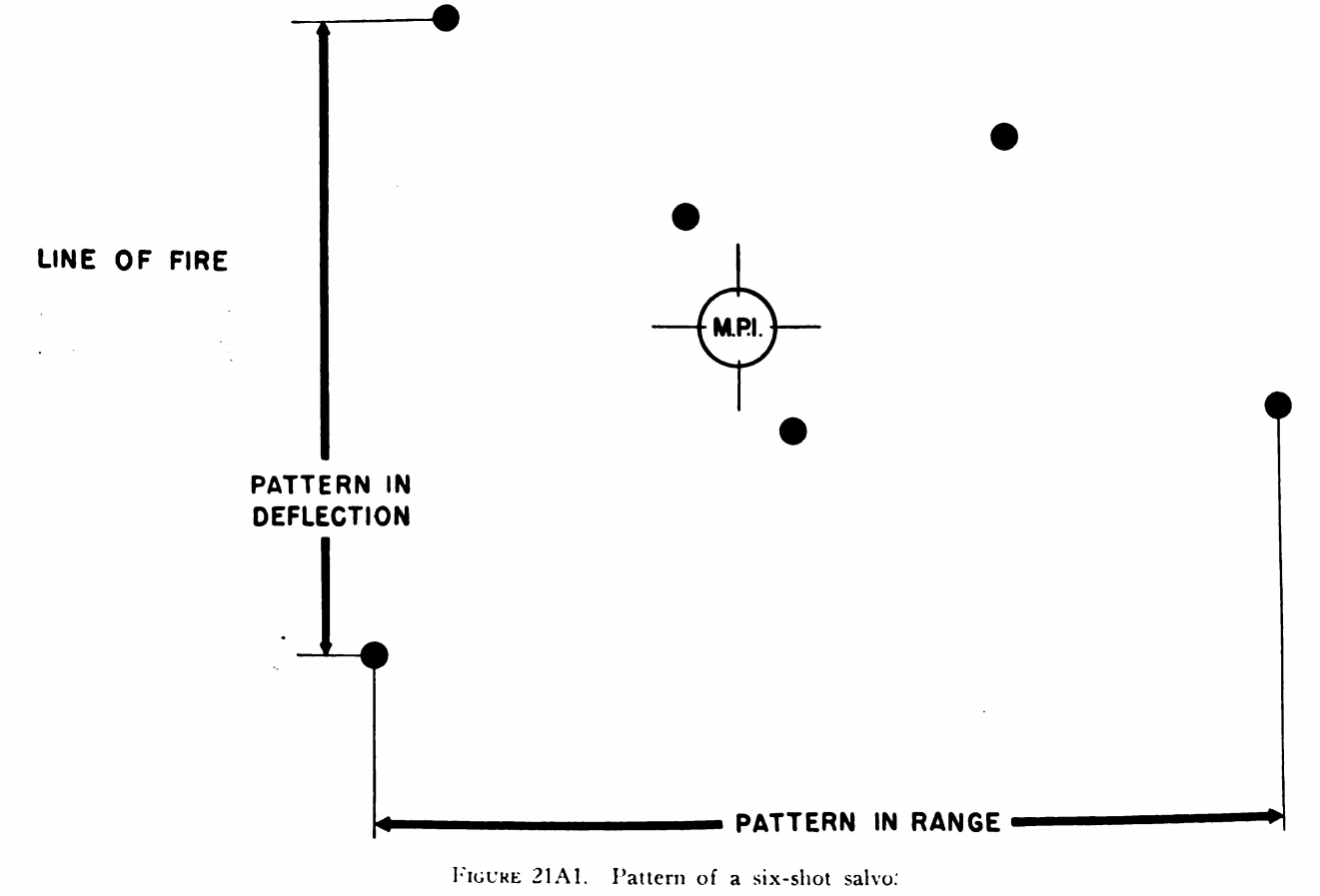The most powerful weapons in the world are useless if they don't hit, and during the battleship era, an incredible amount of ingenuity went into solving the problems of fire control. So far, I've covered in some detail problems like finding the range in the first place and keeping track of it during an action. But as good as those systems were, there was no real possibility until the development of radar that they would pinpoint the target closely enough to get immediate hits. For that, the gunnery team of a ship would use the best data it had, the splashes of its shells that missed the target.

Shell splashes rise near a practice target
In the early days of modern naval gunnery, it was common for each gun to fire independently. Ranges were short, and the gunner could spot his shell's impact by eye. But as ranges climbed, it became easy for a gunner to get confused about which shell was his, and apply the wrong corrections. The solution to this was salvo firing, where a group of guns were fired at once, using the same set of targeting data passed from the central transmitting station. The shells would fall in a cluster, and while hits tended to be invisible, misses raised large splashes. A spotter, usually stationed high on a ship's mast in or near the director, would track where these were and pass that information to the fire-control team, who in turn updated their solution for the target's range and motion.
Firing trials in the years leading up to WWI showed that the best option was to spot first in deflection, and then in range. Deflection was generally fairly easy to spot in (although splashes took some time to form, so a salvo that was correct in deflection tended to look like it was a tiny bit off) and being on for deflection made the next stage much easier, because the spotter could tell if the shells were falling short, long, or on both sides of the target, known as a straddle. Straddles were the objective of gunnery. If shells were falling all around the target ship, it was only a matter of time until it was hit.1

To get straddles, the British developed a set of rules for spotting to bracket the target. The first correction, short or long, would be 400 yards.2 If this was still on the same side of the target, it would be repeated. If it instead crossed the target, an opposite correction of 200 yards would be applied, hoping to close in on the exact range. A last correction of 100 yards would be used if it was still off, which should be enough to straddle the target.3 Now it was just a matter of keeping the target straddled, which isn't as easy as it sounds.
All of the spotting so far was based on the assumption that the range rate for the target was correct, and all of the errors that had to be worked out were purely in range. This was a necessary simplification, but it wasn't particularly accurate, and straddled targets usually turned into ones where the salvoes were short or long. The spotter would thus call in corrections for both range and range rate, usually with a rate correction of half the range correction. So if the shots started falling long, the correction might be "down 200 yards, rate down 100 yards/minute".4 This could also be applied if it took multiple corrections to get on target in the first place.

A 12-gun salvo straddles a practice target towed astern of a battleship
But all of these techniques assume, as did rangekeepers of the time, that the target is on a steady course.5 If the target choose to maneuver instead, it could frustrate attempts at spotting, and at hitting it more generally. The most common technique was "chasing splashes", where a ship would steer for where the last salvo had landed. The theory behind it was that because the rangekeepers and such were continuous in their operation, the one place you could know they wouldn't be aiming was where they had hit last time.6 This was used most notably by the ships of Taffy 3 off Samar, allowing them to survive longer against the massive Japanese fleet they faced.7
Spotting did bring some problems with it. As ranges increased, the time it took the salvo to reach the target could be longer than the interval for reloading the guns. The fire-control team could either accept the reduced rate of fire until the guns were on target, or use a pattern of several salvoes with different corrections to gain information more quickly and hopefully secure early hits. One example of this was the "ladder", where the first salvo might be fired at the estimated range, the second a few hundred yards long, and the third the same amount short. This kind of pattern firing became increasingly important as synthetic fire-control systems became common and ships in combat could be expected to maneuver more, throwing off any attempt to find steady range rates.

A USN Spotting diagram
Another issue was wild shots. Sometimes, a single shell would fall well outside the salvo pattern. This was usually due to a mistake by the gun crew, such as a powder bag loaded with its ignition pad forward or a sight that was set wrong. If salvo of 3 or ideally 4+ shells was fired, it was easy for the spotter to notice the wild shot and throw it out, averaging the remaining splashes by eye. If fewer guns were were used, then the risk of dialing in the wrong correction grew alarmingly.
During WWI, gun ranges continued to rise, to the point that even a spotter aloft couldn't adequately see the splashes of shorts. The obvious solution was to combine two new technologies, radio and the airplane, to give spotters a whole new vantage point, and it was widely adopted during the interwar years. Besides the range increase, the airborne spotter could also get a much better idea of how far short or long the salvo was, making it easier to get onto the target. As a result, most battleships had a few airplanes fitted during the 1920s. Another issue raised by the war were the problems of multiple ships firing at the same target. Some early doctrines attempted to make spotting in this case possible by rigidly synchronizing the ships, so that each salvo fell in a particular timeslot, announced to that ship's spotter by a buzzer set to the estimated time of flight and started when the guns fired.8 In the heat of battle, this often broke down, and most navies chose to fit their shells with bags of dye, allowing each vessel to tell its shell splashes apart from other ships. In action, this seemed to work reasonably well, although the British didn't adopt it until after the outbreak of WWII.

Air spot was not so successful during WWII. Only a handful of surface actions saw it used, most notably River Plate, Matapan and the Komandorskis. Some of this was down to weather and tactical conditions, but the main reason was the development of radar. Not only did it allow more accurate ranging than had previously been possible, to the point that first-salvo straddles became common, but late-war radars could also see the shell splashes themselves and provide direct spotting corrections, even at night. The USN was to demonstrate this capability at Suriago Strait, when Maryland found the target by ranging on shell splashes from other ships with more advanced radar. Air spot instead found itself in great demand for shore bombardment, where radar was of little use.
So far, I've made several references to the spotter being "aloft", and it is obvious that the best place to see the enemy and direct your own fire is from high above the deck. But spotting is only part of what was done up there, and next time, I'll cover the development of the director, the last major piece of the early fire-control puzzle.
1 For this reason, gunnery wasn't always about getting the tightest possible pattern. A tight pattern would give more hits if it overlapped the target, but would otherwise be ineffective. Both the British and Germans came out of WWI believing that the other side would have gotten more hits with looser patterns. The US thought the same of the Japanese during WWII, which was ironic as the Japanese had put a lot of work into reducing dispersion. ⇑
2 The USN believed it could measure how far short or long the salvo was, probably due to its use of steroscopic rangefinders, but the British didn't, and did all of their spotting by rule. Also, note that these corrections were made to the range generated by the rangekeeper, not to the range the previous salvo was fired at. ⇑
3 At 12,000 yards, typical pattern spreads in range were 200 yards for 15" guns, 300 yards for 13.5" guns and 400 yards for 12" guns. The reasons for this are complicated. ⇑
4 This might mean that the target is getting closer more quickly than expected, or that it is going away more slowly. ⇑
5 This assumption was at least somewhat resaonable, because effective fire control before WWII also required the firing ship to hold a steady course. The Germans generally didn't do this during WWI, much to the surprise of the British, because it greatly hindered their accuracy. ⇑
6 I'm not so sure this was actually how it worked. Yes, the FC system isn't going to give the same range/bearing combination as it did last time, but the firing ship is also moving. In practice, I suspect chasing splashes was mostly useful for throwing lots of variability into your motion and preventing the other side's spotter from getting a good fix. ⇑
7 To counter this, the US suggested using "barrage fire", where the ship's secondary guns were aimed at a patch of ocean the target was likely to sail through, and kept there until it had passed, then shifted to another zone. ⇑
8 This buzzer also kept the spotter from correcting the wrong salvo when the ship was in rapid fire, a process known to the USN as "pyramiding". ⇑

Comments
Maybe this will come up in the later posts on the subject, but I would be curious who were the best gunners during various conflicts, and how widely was it known during the conflict itself. If (hypothetically) the Germans had better gunnery in WWI, were the (hypothetical) British aware of it? As a second question that I am almost certain you have answered in previous posts (I'm straddling the target!) how much would those differences matter? Where we have seen examples where world-class gunners ran up the score on scrubs, was there in practice a significant difference between major powers in terms of gunnery (that wasn't entirely technical, like the US having radar).
The basic problem is that gunnery is heavily confounded by conditions, things like visibility and surprise. One of the reasons the German battlecruisers did so much better at Jutland was that the British were just a lot easier to see. When visibility shifted, the British BCs did a lot better. There isn't really enough data in most cases to tease out differences in training and skill as opposed to all of the noise. Another issue is that this wasn't homogenous at a navy level. Beatty's ships didn't have a good place to shoot near Rosyth, while Jellicoe had good ranges at Scapa, and it seems to have shown during Jutland. (Probably. If it wasn't just the visibility issue. The whole thing is extremely complicated.)
There were some cases where one side had a definite advantage, most notably the Japanese in night gunnery, which they trained at a lot more than the US did. But ultimately, naval gunnery was more driven by technology than by the crews, as most dramatically shown during Denmark Strait, where Prince of Wales, with a very green crew, shot very well.
As for figuring all of this out at the time, no way. If it's this hard for historians with all of the records at our fingertips, it was much harder for them at the time.
what do you mean regarding Beatty not having a good place to shoot at Rosyth? Can't you can just head to open water and shoot at a towed target?
In theory, yes. In practice, open water off the British coast in 1916 tended to be infested with U-boats just waiting for a nice, juicy capital ship. This is manageable if you don't spend too long there, but target practice means lingering in the area and giving the bad guys way too many chances. Scapa was big enough that they had a protected area to shoot. The Firth of Forth was a bit too heavily populated for that to work.
I'm sure that the deflection error is much less than the 400+ yards figure for range, but how close behind you is it safe to tow a target?
You'd want quite a bit of distance between the tug and the target just in case someone has a wild shot. Actually, the big danger there is the FC crew getting confused and shooting at the tug instead of the target. I don't remember the exact number, but I think it's 1,000 yards or more.
Both the British and Germans came out of WWI believing that the other side would have gotten more hits with looser patterns.
Such opinions were (should be) locked up very tightly during the war, but how feasible would it be to get such information during the interwar years?
In a fashion comparable to how much data came out of the Russian files after the end of the [first] cold war.
Always wondered, why didn't they use some form of tracer?
Also always wondered, how would chasing splashes work, exactly? Correct me if I'm wrong: you steer your "intended course" plus or minus a delta. The choice of delta depends on where the last salvo fell, in relation to the target. If the shot fell to port, you turn somewhat to port, same for stbd. But you ignore whether the splashes were ahead or behind you. So technically you don't "steer for the splash" so much as choose to dodge left or right based on whether the splash was left or right. Right?
That's what the dye packs were for. Each ship was assigned a color, and you could tell your shell's splashes from the rest by looking at what color it was.
Also, how dangerous was it to be in a spotting aircraft? I can't imagine that the enemy would take too kindly to you buzzing around up there telling your battleship how to correct its aim. Were there any concerted efforts to shoot down spotter aircraft or jam their radios?
Yeah, I've read the post. Possible arguments for tracers vs dye: - using dye means that you have to make sure, before the action, that each ship has separate colors, and there might be 20 ships in the same action; some colors will be similar - confusion is possible; then again, maybe tracers are also less than perfectly distinguishable - not sure about the weight difference between a pyrotechnic charge that has to burn a few seconds, vs however much dye is in "a few bags" (has to be enough to reliably paint a splash that's mostly white water, and probably a lot of it) - if the shell hits, the pyro charge can maybe start a fire; although, maybe the dye is also combustible?
The spotters were hovering above their mothership, right? As safe as it gets, for airspace in a combat zone. But from most books I've read, there was a fair chance the pilot wouldn't get picked up after he landed or ditched.
Was under the impression that it isn't really practical to jam a short-range directional transmission?
@Doctorpat
Don't really know, but military secrecy wasn't then what it is today, so I'd be unsurprised if it came out.
Re tracers, I think the big problem there is brightness. A normal small arms tracer has to work out to maybe a thousand yards. A shell tracer is going to need to burn for 10,000 or 20,000 yards, and it would have to be visible at that range, which means you're going to need a lot more tracer material. (If it follows the inverse square law, then 1,000 times as much to reach 10,000 yards (100 times as much for the same brightness, 10 times the burn length), and 8,000 times as much for 20,000 yards.) Also, there's a decent chance it will come out of the barrel very much on fire, which you probably don't want.
As opposed to this, the amount of dye required was surprisingly small. It was nominally 1.5 lb on the Mk 7 AP shells for the Iowas. And the 20-ship problem is basically ignored on the assumption that all 20 ships are unlikely to be shooting at the same target. Generally, you most have to worry about fire from your division mates, and they're definitely going to have different dye colors.
@AlexT
Your understanding of chasing splashes is correct. As I said in my footnote, I think the standard explanation for it isn't quite right, although it did work.
Re spotting aircraft:
It wasn't that dangerous. You didn't need to get all that close, so shipboard AA wasn't really a threat. Fighters were to some extent, and at one point (mostly in the 20s), "maintain air superiority during a fleet battle and shoot down enemy spotters" was a fairly major carrier role in (IIRC) both the British and American fleets. And the British at least thought about putting fighters on their battleships for the same mission.
Can't speak to jamming. There were probably plans, but not written down where I can find them.
Transmitter wasn't likely to be directional because it's on a plane, and this is way before they could automate that kind of tracking. Receiver might have been, but I don't give good odds.
One other issue I would imagine would also affect the use of tracers is the flight time. To make them effective, you would have to follow them throughout their flight, which could be from 10 to 30 seconds or more, otherwise you could end up confusing your shots with those from another ship in your fleet. That's a lot of time to keep track of a single shot group. With rapid firing autocannons and smaller guns this is less of a problem since there's a trail leading back to you to follow, and flight times are much lower.
@AlexT
The impression I got (possibly from old Biggles novels) is that spotting aircraft were the first military use of aircraft (in land battles) and that shooting down enemy spotters was why fighter aircraft were developed in the first place.
Wow! Ok, makes sense now, thanks.
@Doctorpat Yeah, that's my understanding too. I was referring to naval artillery spotters.
Would it be accurate to say, they were reasonably safe while actually spotting in battle? As opposed to, roaming to search enemy ships or subs, and thus more likely to run alone into hostiles.
In practice, WWII AA tech was basically just up to shooting at people attacking you. Someone who was just looking and didn't need to get close enough to drop bombs was pretty safe. This obviously doesn't apply to fighters, but if you're not looking for carriers, then that really isn't a problem.
Ahem. "With guns big enough you cannot miss". The emperor will guide our fire, heretic. The Inquisition will be dealing with you soon...
@Alexander: This has pictures of a practice with the towing ship 400 yards from the target and the pattern about that long and several times narrower. (Though as this is from around the same time as the two instances I know of where someone was killed when a target-towing ship was accidentally hit, it's very possible that the cable length was later increased.)
@AlexT: I agree that "turn randomly" would seem better than "turn towards the splash", and at least USS Fanshaw Bay seems to have tried that. I don't know why it wasn't standard.
I suspect that chasing splashes worked better than turning randomly because of how bad humans are at randomness. At least you get an approximation of true randomness instead of the very predictable results of telling a person to be random.